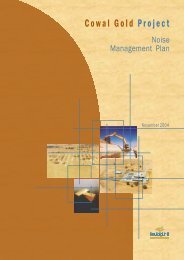January 2006 (PDF 2.9 MB) - Barrick Gold Corporation
January 2006 (PDF 2.9 MB) - Barrick Gold Corporation
January 2006 (PDF 2.9 MB) - Barrick Gold Corporation
Create successful ePaper yourself
Turn your PDF publications into a flip-book with our unique Google optimized e-Paper software.
Cowal <strong>Gold</strong> Project – Cyanide Management Plan<br />
The ambient monitoring units will take continuous readings and display the results in the process<br />
control centre. In addition to the ambient monitors, employees may be required to carry personal<br />
monitoring units in designated areas.<br />
Both personal and ambient HCN gas monitoring units will trigger alarms at the National Occupational<br />
Exposure Limits detailed in the relevant MSDS (Appendix C). Ambient monitoring units will be<br />
equipped with a flashing light and siren. Personal monitoring units will vibrate and sound a high<br />
pitched alarm.<br />
Section 7.1.1 describes the procedure that will be followed in the event the ambient or personal<br />
monitoring units trigger an alarm, while Section 7.1.2 outlines the contingency measures available to<br />
reduce levels of HCN gas for employee safety.<br />
6.4 DETECTION OF CYANIDE MOVEMENT BENEATH AND ADJACENT TO THE TAILINGS<br />
STORAGES<br />
Consent Condition 8.2(b)(v) requires a monitoring programme to be established for the detection of<br />
cyanide movement beneath and adjacent to the tailings storages.<br />
As discussed in Section 4.2.3.3, the tailings storage facilities were assessed in the Project EIS (North<br />
Limited, 1998) for their potential seepage impacts on groundwater (quality, flows and levels).<br />
Monitoring of CNWAD levels will be undertaken at a network of groundwater monitoring bores to monitor<br />
cyanide movement beneath and adjacent to the tailings storages, namely:<br />
• down-gradient bores P412 A & B, P414 A & B, P418 A & B;<br />
• up-gradient bores P555 A & B, P558; and<br />
• tailings storage monitoring bores MON-01 and MON-02.<br />
The locations of the groundwater monitoring bores are shown on Figure 3. The groundwater<br />
monitoring bores will be sampled for CNWAD quarterly. Sampling of the groundwater monitoring bores<br />
will be undertaken using the AS/NZS 5667:1998 Water Quality – Sampling series. In accordance with<br />
EPL 11912, analysis of the groundwater monitoring bores will be conducted using American Public<br />
Health Association (APHA) (1998 or subsequent version) Standard Methods for the Examination of<br />
Water and Wastewater. Water quality samples will be labelled and placed in a refrigerator within one<br />
hour (or chilled on ice and kept in the dark). Samples will be sent by the following working day for<br />
analysis at an off-site NATA-accredited laboratory.<br />
Regular water quality sampling of the water collected in the seepage cut-off drain will also be<br />
conducted and analysed for CNWAD levels.<br />
A laboratory CoC will be completed for each batch of samples. A copy of the CoC will be provided to<br />
the laboratory along with the water samples. A copy of the CoC will be retained on-site.<br />
In addition to the abovementioned bores, groundwater quality monitoring bores P415A, P415B, P416A,<br />
P416B, P417A and P417B (Figure 3) will also be monitored for CNWAD in accordance with EPL 11912.<br />
The CNWAD results that are obtained for the groundwater bores will be recorded and retained as<br />
required by EPL 11912.<br />
HAL-02-07/1/25/CMP-01-Q.DOC 20 BARRICK

















